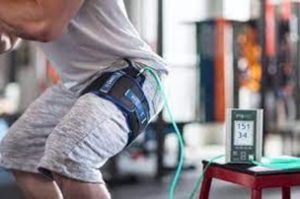Blood flow restriction training or BFR training is a variation of exercise which sees individuals wear a cuff to limit blood flow to specific muscles during exercise. BFR training is performed to change the type of stress which muscles experience during resistance training. Where standard resistance training uses mechanical tension (high loads and prolonged time under tension) to induce muscle microtears, BFR uses metabolic stress to achieve the same result. The BFR cuff is worn proximally to the target muscle (for example, if you want to restrict blood flow to your biceps/triceps, the cuff will wrap around the arm – just below the shoulder) and restricts venous blood return to the liver, this increases the amount of lactate which accumulates in the blood surrounding the target muscles, thus increasing metabolic stress.
As metabolic stress is the major stimulus incurring muscle repair (leading to hypertrophy and strength gains), the weights used during BFR training can remain light. This means that any mechanical tension of joints and ligaments is minimal – making BFR training ideal for rehabilitation practices. Studies have shown BFR training to significantly accelerate rehabilitation timelines compared to non-BFR rehabilitation protocols. This is due to the high loads needed during exercise to provide enough of a stimulus to induce a physiological response in the muscle. Injuries or conditions which limit an individual’s load bearing capacity (ligament/tendon damage or joint pain) can impact the quality of exercises appropriate for their rehabilitation. BFR allows such individuals to achieve similar results to regularly functional populations in the gym, enabling a greater response to exercise interventions and accelerating their return to normal function.
BFR can also be used in athletic performance, and had previously been used to provide a substantial muscular stimulus whilst the athlete is in a de-load week (reducing total exercise volume for a week). This enables athletes to continue training without overloading their bodies, which can predispose them to future injury.
BFR can provide substantial benefit to most populations if conducted correctly.
There is a lot of variation in methods of BFR training. Types of cuffs, amount of pressure, amount of occlusion (restriction of blood), and of course the volume of exercise performed all impacts on the outcomes of BFR. It is important to find a combination of these variables which suits you best.




